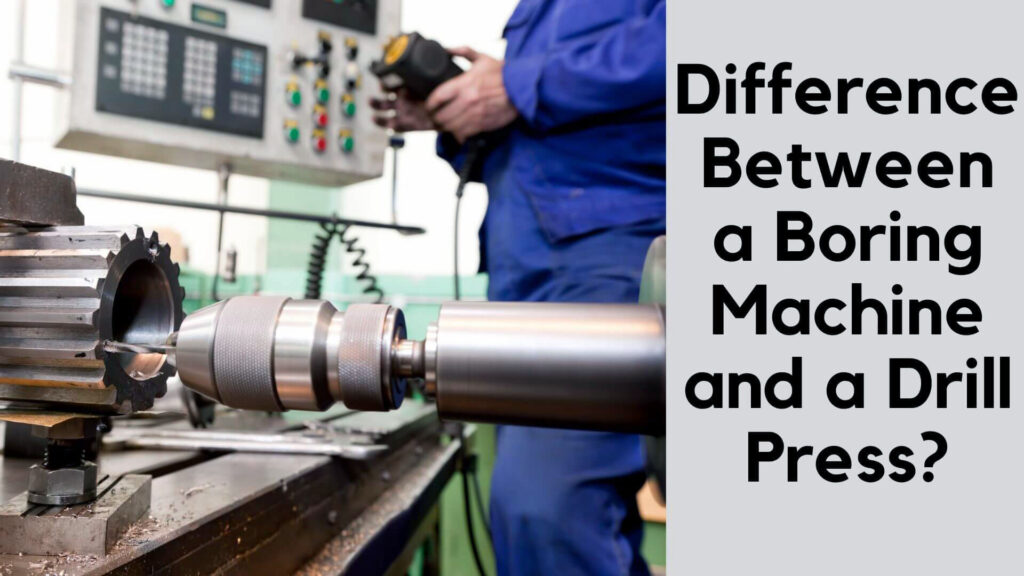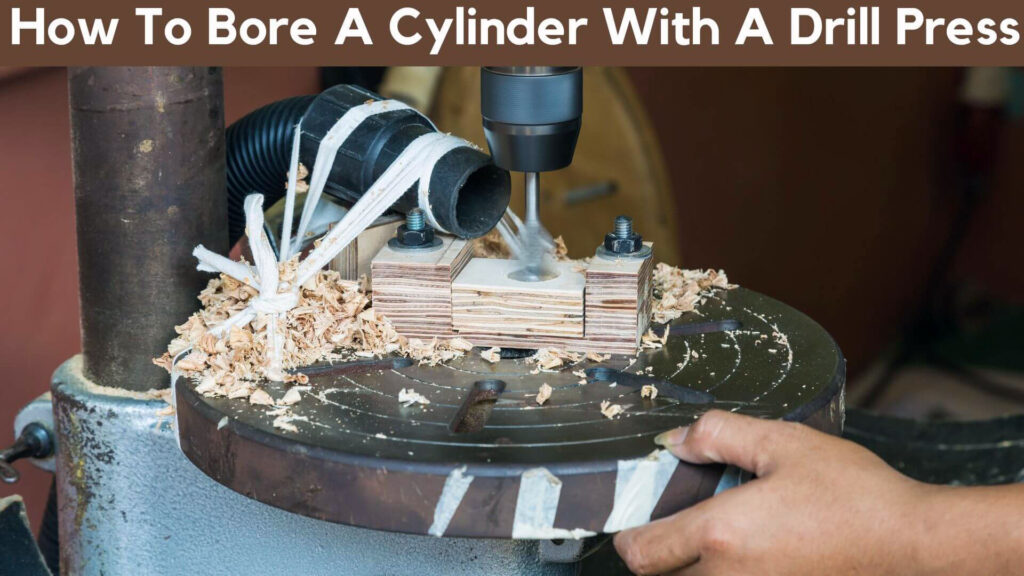Boring a cylinder is a crucial step in many mechanical and automotive tasks, as it ensures the cylinder is precisely sized and shaped for optimal performance. Whether you’re refurbishing an engine or working on a mechanical part, using a drill press to bore a cylinder is a practical and efficient method for many hobbyists and professionals alike.
In this blog post, I will explore how to bore a cylinder with a drill press, the necessary steps to follow, and safety precautions to ensure a successful operation in just minutes.
Table of Contents
What is a Bore?
A bore refers to the interior diameter of a cylindrical object, such as a cylinder in an engine, pipe, or tubing. In the context of engines, boring refers to the process of enlarging or refining the cylinder’s diameter to achieve a precise measurement, which may be necessary for repair, increased performance, or better fitting of components like pistons.
Boring a cylinder typically involves removing a small amount of material from the inside of the cylinder to smooth out imperfections, correct alignment issues, or resize the cylinder for new components. In mechanical terms, boring is different from drilling, as it is more about precision and refinement rather than creating a new hole.
Key Terms Related to Bore:
Honing: A secondary process that smooths the inside surface of a bore after boring.
Bore Diameter: The measurement of the inside width of a cylinder.
Cylinder Boring: The process of enlarging or refining the bore diameter.
What is a Bore Size?
Bore size refers to the diameter of the hole inside the cylinder, which is critical for ensuring the cylinder functions properly, particularly in internal combustion engines. Bore size can influence the power output and efficiency of an engine, as a larger bore allows for more air and fuel, thus increasing power. In many applications, bore size must be precise to ensure optimal performance and avoid engine damage.
Common Bore Sizes:
- Standard Bore: Refers to the original size of the bore as manufactured.
- Overbore: Occurs when the bore is enlarged beyond the standard size, usually to accommodate larger pistons or to repair wear and tear.
Bore sizes are typically measured in millimeters or inches, and the precise measurement will depend on the engine or mechanical system you are working with.
Read More: How To Use A Hole Saw On A Drill Press To Cut Holes Easily
What is the Difference Between a Boring Machine and a Drill Press?

Both boring machines and drill presses are used to create or enlarge holes in materials, but they differ in their precision, power, and primary use cases.
Boring Machine:
A boring machine is a specialized tool used to create or enlarge holes with extreme precision. These machines are typically larger, more powerful, and designed for heavy-duty tasks, such as boring engine blocks or industrial machinery components. Boring machines are specifically engineered to handle tight tolerances and produce highly accurate results.
- Pros: High precision, suitable for deep bores and larger workpieces.
- Cons: Expensive, requires advanced skills, typically used in professional machine shops.
Drill Press:
A drill press is a versatile machine that can be used for drilling, boring, and even some light milling. While not as precise as a boring machine, a drill press can be adapted for boring tasks with the right tools and techniques. It is ideal for smaller projects or those working on a budget.
- Pros: Affordable, versatile, easy to use for light boring tasks.
- Cons: Limited precision compared to boring machines, not suitable for very deep or complex bores.
Key Differences:
- Precision: Boring machines offer greater precision.
- Use: Drill presses are versatile and used for a variety of tasks, while boring machines specialize in boring operations.
- Power: Boring machines are more powerful, making them suitable for heavy-duty jobs.
Difference Between a Standard Bore and a Deep Bore?
The depth of the bore is another important factor in boring cylinders. There are key differences between standard bores and deep bores:
Standard Bore:
A standard bore refers to a bore of shallow or moderate depth, typically in line with the manufacturer’s specifications. Standard bores are usually straightforward and easier to achieve with a drill press.
- Application: Common in everyday engine repairs or light mechanical work.
- Tools: Standard drill bits and boring tools.
Deep Bore:
A deep bore involves boring a hole that extends further into the material, requiring specialized tools and techniques to ensure accuracy and avoid misalignment. Deep bores can be challenging to achieve with a drill press, as maintaining precision over a longer depth can be difficult.
Tools: Requires extended drill bits, specialized boring tools, and careful setup.
Application: Necessary for larger or more complex components, such as industrial machinery or certain engine designs.
Read More: Some Reasonable Cross Slide Drill Press Vise
How Do I Bore A Cylinder With A Drill Press?
Boring a cylinder with a drill press can be accomplished with the following step-by-step guide. Precision and patience are key to ensuring success.
Step 1: Gather Your Tools
To bore a cylinder, you’ll need:
- A drill press.
- A boring head or boring tool attachment.
- Measuring instruments like calipers and micrometers for accuracy.
- A clamping device or vise to secure the workpiece.
- Cutting fluid to reduce friction and keep the tool cool.
Step 2: Secure the Workpiece
Place the cylinder or workpiece securely in a vise or clamping device attached to the drill press table. Ensure that the workpiece is aligned properly with the drill bit or boring tool to avoid misalignment during the process.
Step 3: Set the Drill Press Speed
Set the appropriate speed on the drill press for boring. Boring requires slower speeds than regular drilling to maintain precision and avoid overheating the tool. Consult the material specifications for the correct RPM setting.
Step 4: Attach the Boring Tool
Install a boring tool or boring head attachment onto the drill press spindle. Ensure it is secured tightly and aligned correctly. Boring tools are designed to enlarge the existing hole with precision.
Step 5: Start Boring
Lower the spindle slowly into the cylinder, making sure to apply steady pressure. Allow the boring tool to do the work—don’t force it. Move the tool in small increments to maintain control and precision.
Step 6: Check the Diameter
Stop periodically to check the diameter of the bore with a caliper or micrometer. This ensures that you’re not removing too much material and that the bore remains within the desired tolerances.
Step 7: Finish the Bore
Once you’ve reached the desired diameter, withdraw the tool slowly. Apply cutting fluid throughout the process to prevent overheating. Inspect the finished bore for smoothness and accuracy.
Safety Measures
Safety should be a top priority when boring a cylinder with a drill press. Here are some essential safety measures:
- Wear Safety Gear: Always wear protective gear such as goggles, gloves, and ear protection.
- Secure the Workpiece: Ensure the workpiece is firmly clamped or secured in a vise before starting.
- Check the Drill Press: Make sure the drill press is in good working order, with all components securely fastened.
- Use Cutting Fluid: Cutting fluid reduces friction and prevents overheating, minimizing the risk of damage to the tool or workpiece.
- Avoid Distractions: Stay focused while operating the drill press to prevent accidents or mistakes.
FAQS About How To Bore A Cylinder With A Drill Press
Can I bore a cylinder with a standard drill bit?
No, a standard drill bit is designed for creating holes, not enlarging or refining existing holes with precision. You need a boring head or boring tool for accurate cylinder boring.
What is the best type of boring tool for a drill press?
A boring head attachment with adjustable cutting tools is the best option for boring cylinders with a drill press. It provides the precision and control needed for boring tasks.
How do I ensure the cylinder is aligned correctly on the drill press?
Use a precision vise or clamping system to hold the cylinder securely in place. You can also use dial indicators or alignment tools to ensure proper positioning.
Can I use a handheld drill for boring a cylinder?
A handheld drill lacks the precision and stability needed for boring tasks. A drill press or boring machine is essential for accurate cylinder boring.
How can I prevent overheating while boring?
To prevent overheating, apply cutting fluid during the boring process. This reduces friction, cools the tool, and prolongs the life of your boring attachment.
Final Thought
Boring a cylinder with a drill press may seem like a complex task, but with the right tools, techniques, and safety precautions, it can be done efficiently and accurately. By following the step-by-step process outlined in this guide, you can achieve precise results in just minutes. Whether you’re working on engine repairs or other mechanical projects, mastering the skill of cylinder boring with a drill press will add a valuable technique to your workshop arsenal.

Hey, I am MD Hrithik Hossain, I’m a huge fan of DIY crafts. My workshop is where I spend most of my spare time, and I’m always working on some project. To that end, I’d like to share some of my knowledge and experience with you in power tools, woodworking, and other specialized materials fabrication.
I will guide you with genuine knowledge that can assist you with deciding whether a drill is appropriate according to your requirements or not. If you want to find the best drill and know which type of drill is most suited for your needs, then I can guide you with my expertise. My passion lies in helping others find the correct products they need at an affordable price.


